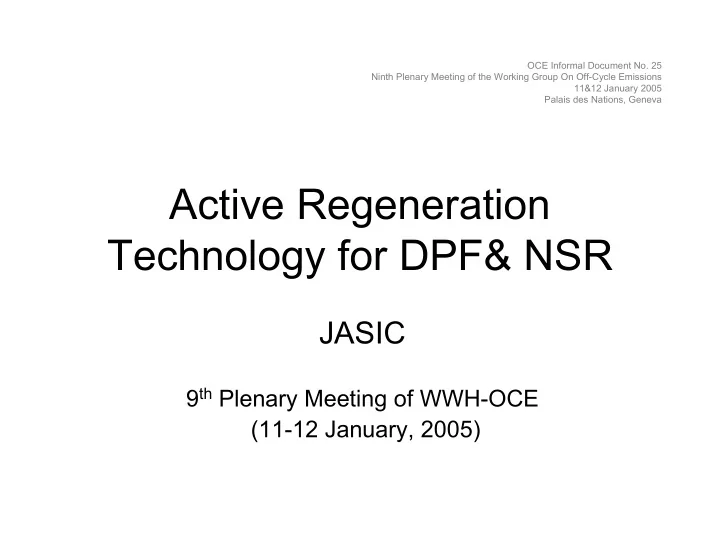

OCE Informal Document No. 25 Ninth Plenary Meeting of the Working Group On Off-Cycle Emissions 11&12 January 2005 Palais des Nations, Geneva Active Regeneration Technology for DPF& NSR JASIC 9 th Plenary Meeting of WWH-OCE (11-12 January, 2005)
Needs for Active Regeneration • Regeneration of accumulated soot on DPF is critical for practical application. • Exh. Temp. in urban driving is not enough for continuous (passive) regeneration of CR-DPF or C-DPF. • Therefore Japanese DPF installed engines in production mostly apply active regeneration technologies. Those differ for each manufacturers’ design philosophy. • An example already presented in SAE2004-01-0824 by Japanese manufacturer. • Active regeneration is also necessary for de-sulfurization of NOx Storage Reduction (NSR) catalyst. Because sulfur in fuel is accumulated on NOx adsorbing material on the catalyst and poisons NOx reduction performance. 2
Passive Regeneration Operating Conditions Maximum Torque Engine Torque (Nm) Passive Regeneration Region Active Regeneration of a Particulate Filter is necessary Urban Cycle with Full Payload Engine Speed (rpm)
Technology Outline for DPF (SAE2004-01-0824) • Accumulated soot amount on DPF is estimated by ECU. When the amount exceed the threshold, active regeneration start to increase catalyst bed temp.. • In the active regeneration process, different injection events (after inj. or post inj.) and different air management occur using electronic control of fuel inj. equipment, turbo-charger and EGR devices. • The process continues several minutes, and during the process, different level of exhaust gases are emitted from tail-pipe. 4
Diesel Engine System to Achieve PM Reduction Common Rail Injection System EGR Valve EGR Cooler Inter-Cooler Diesel Oxidation Catalyst Catalyzed Filter Intake Air Exhaust Gas Air Flow Sensor Temp. Sensor VG Turbo Charger Exhaust Brake DPR-Cleaner Temp. Sensor Pressure Sensor
Example of Regeneration Process of the DPR Normal Operation < α g/L Accumulated Soot Amount ≥α g/L After Injection Exhaust Gas <T ˚ C Temperature ≥ T ˚ C Post injection ≥ β g/L Accumulated Soot Amount < β g/L
Fuel Injection Pattern Fuel Injection Quantity Main Injection After Post Injection Injection TDC BDC Crank Angle
Fuel Injection Control Target of Filter Bed Temp Filter Bed Temp. ˚ C . Feedback Injection Post Time
Filter Temperatures during Active Regeneration (Under City Driving Condition with the Ave Speed of 24km/h) 1000 Filter Bed Filter Front Temp( ˚ C ) 800 600 400 Filter Center 200 Filter Rear 0 Post Injection After Inj. Post Inj. 100 Vehicle Speed 80 60 (km/h) 40 20 0 0 100 200 300 400 500 Time(sec)
Technology Outline for NSR • Fuel rich circumstances for catalyst bed necessary for NSR regeneration to remove sulfur. • In the active regeneration process, much sophisticated injection events (fuel injection to catalyst bed) and air management is necessary for fuel rich circumstances. • The process continues several minutes, and during the process, different level of exhaust gases are emitted from tail-pipe. 10
System Configuration for NSR+DPF System Configuration for NSR+DPF EGR Valve Common Rail Injection System Throttle Valve EGR Cooler NSR Catalyst Pre-EGR Catalyst DPNR Catalyst Inter-Cooler Oxidation Catalyst Exhaust Gas Intake Air Air Flow Sensor Temp. Sensor VG Turbo Charger Air-Fuel Ratio Sensor Air-Fuel Ratio Sensor Temp. Sensor Fuel Injector Pressure Sensor 11
An Example of Active Regeneration (De- Sulfurization) for NSR Catalyst Rich and lean Vehicle Speed 60km/h Const. Air Fuel Ratio 35 30 25 20 Low temp.combustion & EPI 15 10 800 SOx, H2S SO2 600 (ppm) 400 200 H 2 S 0 700 Bed Temp. (deg.C) 600 Cat. Front 500 Cat. Rear 400 300 12 100sec. Time
Summary • Active regeneration is necessary for both DPF and NSR technology. • The regeneration process continues several minutes, and in the process different emission characteristics should be observed. The duration and emission level depend on design. • We propose the different emission characteristics during active regeneration should be considered in OCE-GTR. 13
Recommend
More recommend